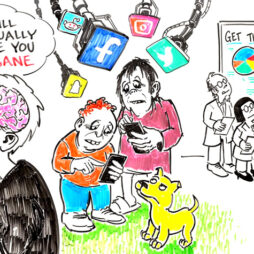The Wall Street Journal | by L. Gordon Crovitz | July 6, 2009
Just in time for summer, Crown Imports has brought back a popular television advertisement for its Corona beer that first aired in 1998. The new one shows a man at the beach skipping rocks into the sea. He decides to do the same with his BlackBerry — a beeper in the earlier version — when it interrupts his relaxation by ringing and vibrating.
The ad addresses one of the key causes of anxiety in the information age: What does it mean that for the first time, information is no longer scarce? We have fast and easy access to the communications and the facts we need, through email, the Web, Facebook, Twitter, text messages and other tools. So now we have the problem of too much supply. How can we escape useless information, unneeded emails and unwanted communications?
Our era in the information age is a transition period of learning how to navigate information abundance. Rather than pitch our BlackBerrys and iPhones into the sea, imagine the benefits once we have figured out how to manage the chaos of endless data and routine multitasking, a process that will help refine our judgment about information and refocus our attention on what’s truly important.
For now, popular culture is more troubled than excited by information abundance. Actress Gwyneth Paltrow told an interviewer last week that she spends so much time in Spain because “they seem to enjoy life a little bit more. . . . They don’t always have their Blackberrys on.” In order to get passengers to pay attention to safety announcements, Air New Zealand decided to show a video of stewardesses and pilots dressed in nothing but body paint.
One of the companies that led the charge on information is trying to make a business out of solving the problem. Xerox says, “We’ve been navigating the flood of information for 70 years — since the first xerographic print launched the ‘sharing era.'” It makes the case that “too much information can make you feel powerless and unproductive,” reporting that more than half of people think that less than half the information they get at work is valuable. Xerox hosts a corporate blog called Information Sanity, with tips on how to cope.
As one data point, a search for “Information Overload” on Google returns 2.92 million results in 0.37 second.
The book “Rapt” by Winifred Gallagher reports that many neuroscientists believe attention is a process of either selecting a topic or not. As suggested by the expression “pay attention,” we have a limited ability to focus. If this is right, young people who do their homework while on Twitter, the phone and YouTube may not be engaging deeply enough. “When you’re finally forced to confront intellectually demanding situations in high school or college,” Ms. Gallagher writes, “you may find that you’ve traded depth of knowledge for breadth and stunted your capacity for serious thought.”
But there’s a more optimistic way to think about the issue. Humans adapt, so we’ll learn how to live with information overabundance. Young people growing up multitasking are already less anxious about using technology and may well cope better than those of us in older generations. They have no choice but to get more sophisticated at separating the important from the unimportant and the authoritative from the unreliable, even while sampling from among many new kinds of information tools.
. . . more

